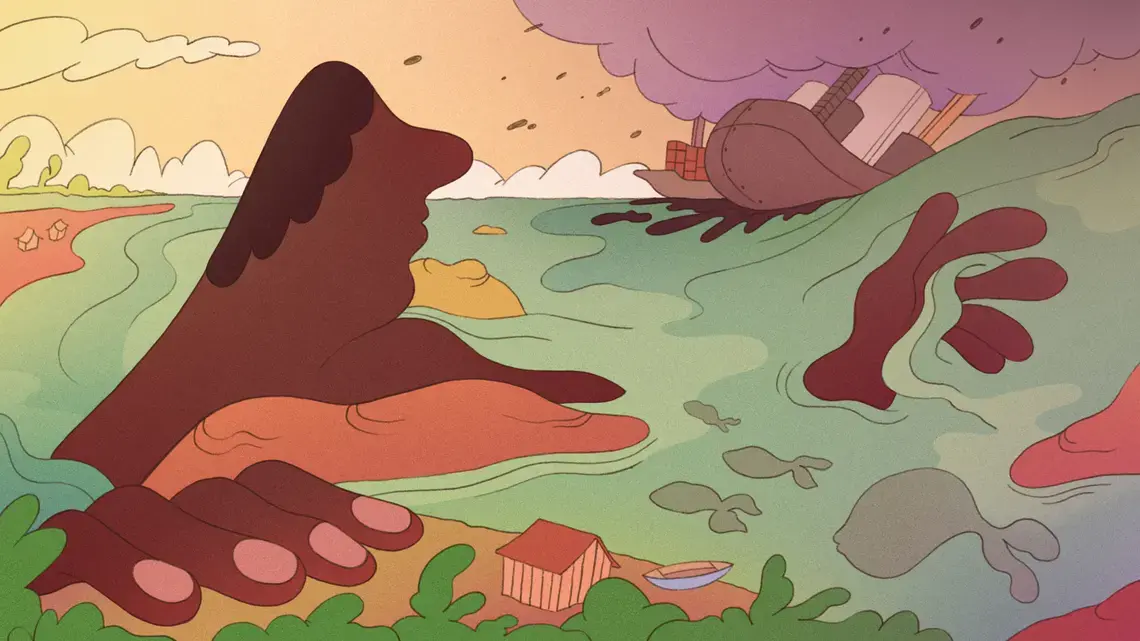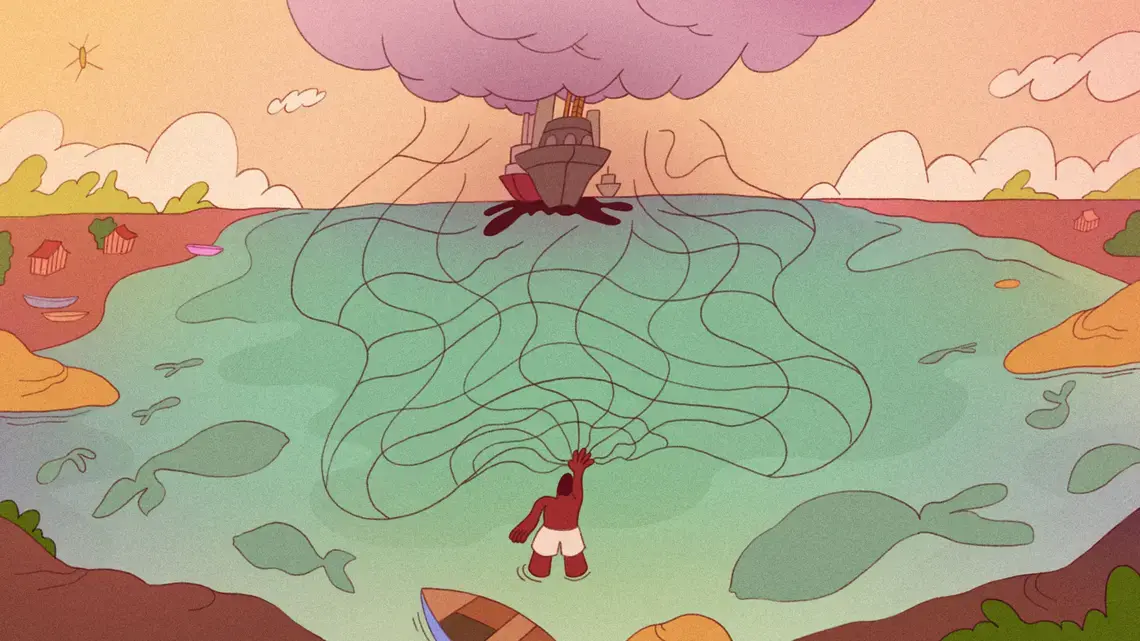José Omir Rodrigues Siqueira, 48, has known the water since before he could walk. He awakens in the quilombola community of Calados on the banks of the Tocantins River in the Brazilian Amazon. His grandson Cairo marks his family’s sixth generation, and Siqueira is the president of the community’s quilombola association. Brazil’s quilombola people are descendants of formerly enslaved Africans, many of whom fled slavery to form communities of free people called quilombos. Like his ancestors, Siqueira fishes the Tocantins River to feed his family. With his brother, Siqueira rows out onto the river in the early morning. He sets his net while his brother hits the water with a stick, and the fish dash inside. He returns home by noon to eat with his family: his wife and their four children who still live at home. As they savor the sun-yellow peacock bass, Siqueira wonders how long they will continue like this.
Brazil’s government plans to industrialize a 186-mile stretch of the river channel from Marabá to Baião in Pará state—the same waters that Siqueira fishes. The construction project would involve dynamiting nearly 22 miles of midriver boulders and dredging over 100 miles of the riverbed to deepen the river and allow large ships’ passage to reach the Atlantic. If all goes as planned, over 244 million cubic feet of rock, sand, and dirt will be removed—leaving the river completely transformed over an estimated four years of construction. The plan is currently in the environmental licensing stage, which is supposed to include consulting with communities. On Dec. 12, 2021, a team contracted by the government arrived at the river in the southern end of the planned channel to mark locations to explode. The river’s demolition feels imminent.
This project would allow agribusiness, mining, aluminum, and coal industries in Brazil to transport their materials on convoys over 650 feet long. At Barcarena port toward the northern end of the industrial shipping channel, materials would be loaded onto ships to more quickly reach China and other export markets. This is part of a larger government-industry plan called the Northern Arc of Brazil, which involves building out new transportation infrastructure in the north to more efficiently send commodities abroad. Powerful businesses—such as Vale, Brazil’s largest mining company; Cargill; and Aprosoja, a soy lobbying group endorsing the plan—stand to benefit.
The proposed shipping route has already led to agribusiness buying up rural properties and planting soy and corn plantations in Baião municipality in the Amazon, according to interviews with locals conducted as part of this investigation involving interviews with more than 45 residents and experts since 2019. If the channel increases the amount of soy, corn, and minerals shipped as government officials are touting, we can expect further clearing of both the Amazon and the Cerrado, the arid Brazilian savanna that covers 21% of the country’s land area and produces most of the country’s grain—all to make room for industry interests.
But over 50 traditional and Indigenous riverbank communities protest that they haven’t been consulted by the government. They worry this project will kill the fishery and threaten the very cultural practices by which they not only maintain their cultures but also preserve the river-forest ecosystem.
Among communities to be affected are at least 20 quilombola communities whose ancestors were once enslaved in this part of the Amazon to serve another monoculture: sugar. Assailed now by advancing monocrops of soy and corn, the quilombos of the waters (as some call themselves) are worried about the future. As Siqueira said, an industrialized river channel would push them off the water and onto the land. Meanwhile, agribusiness is pushing them from the other side, coming ever closer, buying up lands around them and pressuring people to sell.
Though the quilombos have persisted for hundreds of years, they are now squeezed on both sides, worried for their physical safety and wondering out loud how their grandchildren will manage to continue to be quilombos of the waters.
Siqueira knows by memory what fish have already disappeared from the Tocantins River. He can name over a dozen species. He winces at mentioning the surubim, a tiger shovelnose catfish. It can grow over four feet long with a whiskered grey submarine snout, expressive black stripes and spots, and translucent blue fins that look like wings. Seeing them disappear was “the most difficult thing,” Siqueira said. “You don’t see them anymore.” (Most interviews for this article were conducted in Portuguese.)
This loss predates the plans to deepen the shipping channel. In 1984, the military dictatorship completed construction of the Tucuruí hydroelectric dam, which the community considers the “first impact” to the river, Siqueira said. It caused bank erosion, sediment changes, and interruption to the seasonal flooding cycle fish need to reproduce. Communities still remember how horrified they were to see species after species disappear. They were never consulted beforehand or compensated afterward.
Losses continue today: When engineers retain water through the dam in what should be peak flooding season, freshly laid fish eggs are exposed in the forest and eaten by predators, Siqueira attested. Over a dozen fish are now gone—the knowledge shared by oral tradition. His father and the other elders recite these names.
“So much is happening—and now here comes the dredging,” Siqueira said. “It’s going to finish off what we have left.”
Quilombola communities like Siqueira’s know the forest and its waterways intimately. Their independent Black settlements have existed for centuries in the Amazon Rainforest. In the mid-1700s, the Portuguese made economic reforms to incentivize plantations, causing a leap in the trafficking of enslaved African peoples to Belém, which was then the capital of the colonial sub-division called the Captaincy of Grão-Pará (lands that cover current-day Amazonas and Pará states). Today, hundreds of quilombola territories exist on lands their ancestors—and they themselves—have fought hard to hang onto.
The project’s affected area sees an especially high concentration of quilombos: 163. Starting in the mid-1700s, enslavers chose to establish sugar plantations in coastal areas where the northern Amazon meets the Atlantic due to the dramatic tides brought on by the convergence of river and seawater, said Oscar de la Torre, a history professor at the University of North Carolina and author of The People of the River, a book on Afro-Brazilians. These tides powered the sugar mill. The proximity to Belém, which held the country’s principal port, meant it was efficient to ship sugar and cachaça to markets, he said.
"The river doesn’t operate in pieces. It’s a river. It doesn’t have departments."
CARMEN FORO
WORKERS’ UNION CENTER
While some people enslaved on these sugar plantations fled to form quilombos deep in the forest, others formed their own settlements on the water after the plantation owners relinquished their holds on the lands. Once Brazil finally abolished slavery in 1888, many plantation owners first rented land to former slaves, then abandoned the sugar trade altogether. “Running sugar plantations without free labor from slavery wasn’t very profitable,” de la Torre said. As a result, quilombolas exist on the same lands their ancestors once labored for someone else’s profit.
Now, further exploitation of the land and resources inches closer to the quilombola settlements that survived slavery. At risk is their identity. For centuries, these people have creatively adapted to the dramatic tidal swings of this river zone that once lured enslavers to construct sugar mills here. Their ancestors defiantly outlasted them, persisting and recreating their culture in the very same lands where they’d been enslaved. Now, they must worry whether they’ll be able to navigate their boats if the river becomes privatized for ships. They must worry about fish populations and pollution.
The Tocantins River fills a vast network of tributary rivers, streams, creeks, and even lakes, which quilombola residents depend upon for fishing, drinking, bathing, and irrigating crops. In Baião municipality, the Tocantins River forks into two branches. The government plans to dredge the right branch, which is naturally deeper, as part of its development project. However, these branches feed hundreds of streams, too.
“Our river fills the channels and islands and other rivers behind it and many villages, as well,” said Elpídio da Glória Torres (known as Goianinho), 66, co-founder and president of an association of 12 quilombos in Baião municipality. He worries dredging the river will affect the entire freshwater system.
Other quilombo association leaders share this apprehension, too. They’ve already observed water levels drop since the construction of the Tucuruí dam. The unique river-fed lakes of the region are a fluvial anomaly in which fish shelter and spawn. Torres said these lakes have been affected by the dam, too. He is worried these lakes will continue to lose water. As water drains into the dredged branch, geographer Edir Augusto Dias Pereira of the Federal University of Pará (who grew up in São Benedito of Viseu quilombo) anticipates that the water level in the shallower left-hand branch of the Tocantins may decrease as water drains into the new channel. “Everyone knows fish breed in those lakes,” Pereira said, but they haven’t been studied and have been negatively impacted since the dam. Fish numbers could drop further if the river is excavated, he said.
Such scenarios sound possible to hydrologist Ayan Fleischmann of the Mamirauá Institute for Sustainable Development, but he stressed the need to thoroughly study the hydrology of the area, which hasn’t been done. “If you remove sediments from the riverbed, you change the hydrological balance of the river,” he said. This can lead to riverbank erosion, as well as decreased connectivity across the system more broadly. Then, there’s climate change, which is projected to make less water available in this part of the Amazon. “If you have much less water, then perhaps the ships can’t pass any more,” Fleischmann said.
That’s why a proper environmental review is so important. Brazil’s National Department of Transportation Infrastructure (DNIT) has already contracted São Paulo-based DTA Engineering to demolish the river. DTA Engineering is also the company in charge of conducting environmental studies. Meanwhile, IBAMA, the Brazilian Institute of Environment and Renewable Natural Resources, has twice evaluated and asked for further studies in DTA’s environmental impact studies, which are also supposed to include economic and sociological impacts on communities. One of the missing elements, according to IBAMA, is a study to monitor river sediments in the Lower Tocantins. (DNIT didn’t respond to questions on errors and missing studies for this story.)
The environmental studies also fail to include the full scope of the impact area, said Carmen Foro, 55, the national secretary general of the Workers’ Union Center, Brazil’s biggest trade union. The assessment doesn’t include municipalities north of Baião that may be affected by these changes. “The river doesn’t operate in pieces,” she said. “It’s a river. It doesn’t have departments.”
In September 2020, IBAMA’s technical team identified numerous methodological flaws in the environmental review, including missing data on turtles, fish, fishing, and the communities themselves, said Cristiane Cunha, a biologist specializing in fishing and professor at the Federal University of South and Southeast Pará. IBAMA’s issuance of an environmental license is supposed to be contingent on the company submitting missing and faulty research.
Cunha infers DTA has no intention to conduct any of the studies IBAMA ordered. She, other experts, and residents fear IBAMA’s politicization under President Jair Bolsonaro may cause its top administrators to grant the environmental license despite these flaws and human rights concerns around consultation. It reflects the administration’s approach of “passar a boiada,” which translates to “letting the herd pass through” in English, a Brazilian phrase used to mean ushering in legally and environmentally questionable projects of benefit to business interests.
All of this will likely impact the fish that survived the dam intrusion, said Marcelo Andrade, an ichthyologist at the Federal University of Pará. Other endangered animals also live here, including the little-studied Araguaian river dolphin, river turtles, and birds. Andrade said the dredging of the river may harm the reproduction and feeding of fish species because it may make habitats more homogenous, ripping up vegetated and rocky areas, as well as breeding sites.
Many fish species in this ecosystem also depend on the river’s seasonal flooding, Andrade said. The arrival of the rains stimulates their reproduction as the river begins to fill come October. “The process of dredging the river will culminate in the modification of this stimulus that the environment provokes in the fish and certainly will negatively impact the fishes’ reproductive process,” Andrade said.
Ichthyologist Alberto Akama of the Emílio Goeldi Museum research institute noted the threat of industrial barges releasing oil and heavy fuel, too. The region has been marked by industrial accidents. There’s the 2015 sinking of 5,000 live cattle, the 2018 Hydro Alunorte bauxite spill, and the burning of sodium hydrosulfite during an explosion from French mining company Imerys Rio Capim in December. Akama also worries about Brazil’s more toxic pesticides, many of which are prohibited outside the country. Andrade said any variation in the chemical composition of the water will negatively impact fish species because of reduced oxygen in the water, which can affect their breathing, as well as hormonal alterations in the fishes.
This is why leaders of the quilombos of the Lower Tocantins are organizing to get the word out to their fellow residents. They refuse to accept the planned excavation of their river. They’re mobilizing to stop it. They’re demanding they be heard by a government that has so far refused to consult with them as required by the International Labor Organization’s Convention 169, which calls for formal free, prior, and informed consultation of Indigenous and traditional peoples in any project impacting them, to which Brazil is a signatory.
The impact is environmental, cultural—and personal.
“We can under no circumstances accept this environmental impact in our region,” said Torres, president of the quilombo association in Baião municipality. “A huge project for the draining of our river is not only an affront, but a means to kill all aspects of our quilombola people, of our riverbank peoples.”
Over 200 feet in the middle of the Tocantins River would be reserved for ships if this plan goes through. What does this mean for Siqueira’s daily fishing trips? He’s used to traveling freely on the water with his family. The river has never belonged to anyone—not even the quilombos consider themselves its owner. With their traditional knowledge, they help keep the river clean and the forest standing. But they reckon that “big capital,” as they call it, is coming to undo all that. Since the dam decimated the populations of dozens of fish species, residents have worked hard to manage the fish populations that remain. What’s at stake is a generational, collective wisdom that keeps the forest and fish alive—and which agribusiness and mining companies would supplant with a privatized river.
“This ship will choose—and not all of us—when is the time to go get our fish,” Siqueira said. “I’m sure that we’re no longer going to be able to get our sustenance from the river to feed ourselves. We aren’t going to be able to bathe in this water. No one is going to be able to do anything in this water… We are very sad about this.”
These communities also understand that it’s no accident that almost all of them don’t have land titles, even though they’ve petitioned the government for them. Article 68 of Brazil’s 1988 constitution promised collective land titles to traditionally occupied quilombola lands. Responding to a lack of public data, the Pro-Indian Commission of São Paulo, which helps guarantee territorial rights to Indigenous and quilombola people, wrote in an email that its data bank counts 1,916 quilombola lands, 1,779 of which have applied for collective titles. But just 137 of these quilombos have received titles. Some are recognized but not titled: Calados quilombo was recognized in 2018 but still hasn’t received a land title. Not having land titles leaves them more vulnerable, explained Clodoaldo da Silva, president of São Bernardo quilombo. “The land can be vulnerable to being sold and bought by people who have an interest in that piece of land for big agribusiness plantations and farms,” he said.
The situation grew more severe when Bolsonaro was elected in 2019. While campaigning, he repeatedly vowed to demarcate “not one centimeter more of Indigenous or quilombola land.”
The Palmares Foundation, a government body that is supposed to support Afro-Brazilian culture and initiate the first phase in quilombos’ land titulation, was recently being led by Sérgio Camargo, a Bolsonaro appointee who has spoken out against the country’s Black movement. “He shouldn’t be president of Palmares,” said Cristivan Alves, a press spokesperson for Malungu, an association advocating for quilombos’ rights in Pará. Camargo was suspended in October over discrimination allegations.
"We have to act collectively so this river doesn’t become a legend."
CARMEN FORO
WORKERS’ UNION CENTER
The Palmares Foundation is also supposed to coordinate with other governmental institutions to guarantee quilombos throughout Brazil receive proper consultation for any project that will affect them, yet Siqueira said his community hasn’t been consulted about the project so far. Maria José Brito de Sousa, fiscal director for São José do Icatu quilombo and one of Malungu’s directors, said someone came to talk to her community association’s president in 2019, but a conversation isn’t consultation. Torres agrees.
“What DTA Engineering did is come here in the community, grab the president, a random person there, do an interview, and leave,” Torres said. “In reality, there never was consultation.”
The quilombola communities worry the government will skip a proper consultation process for the river dredging and demolition. They’ve been trying to inform residents of the project to stop it, said Foro of the Workers’ Union Center. In 2019, she and other groups convened 180 Lower Tocantins leaders. In 2021, they brought together 120 leaders again to exchange information and discuss strategies to mobilize against the industrial shipping channel. She stresses the importance of opening a space of dialogue with the government to secure land titles for quilombos and other rural peoples. She wants to see the government develop economic programs to help communities with the channel’s expected food security impacts, as well as conduct an education campaign for communities to understand the project.
“There is a quilombola right,” she said. “These quilombolas have lived for centuries on these lands… We have to act collectively so this river doesn’t become a legend.”
The quilombos find themselves defending the water—but also the land. Clodoaldo da Costa, president of an association of four quilombos, explained that loggers are entering illegally and cutting trees without consulting the community. It shouldn’t work that way because the quilombos have collective-use agreements, not individual-use agreements. As historian Celeste Pinto of Federal University of Pará explained, these loggers take advantage of poverty to pay off individuals to let them log certain trees fetching a good price. In this region, loggers are often looking for trees like maçaranduba, which can stand over 164 feet tall, and Brazil nut trees for furniture and houses.
However, outsiders are also buying up lands around the quilombos to plant soy and corn. In Baião municipality, the amount of temporary crops sown and harvested in the same agricultural year jumped from 1,235 acres in 2018 to over 25,000 acres in 2020.
“The worry is we don’t know what’s going to happen with our people, our children, and our grandchildren,” Siqueira said. “That’s the truth. We were raised this way, searching for our food there in the river. And to know you’re going to lose all this, it’s very painful—you feel really sad. It hasn’t happened yet, and we’re already feeling it.”
He refuses to give up his people’s connection to the land—or the water.
“They already came to me,“ he paused. “They came to me to try to enter our community.”
“I didn’t consent, no. I said no. We have our community’s protocol. I have a huge responsibility within our community. They didn’t manage to enter, no!” Siqueira exclaimed, as if saying it again to these outsiders.
Repeating this No, almost in a rhythm, it was as though he was reliving the stress of being face to face with these bankrolled strangers trying to enter his land. He’s scared of what they’ll do next.
“We’re afraid because they are coming close to us,” Siqueira said. “We’re afraid because they are dangerous. They have money. And they’re coming closer.”
- View this story on Clima Info


























